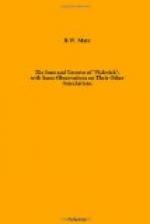“We went to the ‘Golden Cross,’” he says, “then a mouldy sort of establishment in a close neighbourhood. A waiter showed me into the coffee-room, and a chambermaid introduced me to my small bedchamber, which smelt like a hackney coach and was shut up like a family vault.”
Later in the evening he met his old school friend, Steerforth, who was evidently on better and more familiar terms with the waiter, for he not only demanded, but secured a better bedroom for David.
[illustration: The Golden Cross Hotel, Charing Cross, in 1828. From an engraving]
“I found my new room a great improvement on my old one,” he says, “it not being at all musty and having a fourpost bedstead in it, which was quite a little landed estate. Here, among pillows enough for six, I soon fell asleep in a blissful condition, and dreamed of ancient Rome, Steerforth and friendship, until the early morning coaches rumbling out of the archway underneath made me dream of thunder and the gods.”
This comfortable new aspect of the inn did not stop at his bedroom, for he took breakfast the next morning “in a snug private apartment, red-curtained and Turkey carpeted, where the fire burnt bright and a fine hot breakfast was set forth on a table covered with a clean cloth. . . . I could not enough admire the change Steerforth had wrought in the ‘Golden Cross’; or compose the dull, forlorn state I had held yesterday with this morning’s comfort and this morning’s entertainment.”
It was on another occasion later in the story that David Copperfield, then lodging in Buckingham Street close by, encountered poor old Peggotty on the steps of St. Martin’s Church. It was a snowy, dismal night and Peggotty was resting on his journey in search for Little Emily.
“In those days,” says Dickens, “there was a side entrance to the stable yard of the ‘Golden Cross’ nearly opposite to where we stood. I pointed out the gateway, put my arm through his, and we went across. Two or three public rooms opened out of the stable yard; and looking into one of them, and finding it empty, and a good fire burning, I took him in there.”
The side entrance here referred to was at the time in St. Martin’s Lane—that part of it which then ran down from St. Martin’s Church to the Strand. It led into the stable yard, backing into what is now Trafalgar Square, and was part of the old inn of Pickwick and The Sketches, and not of the present one, which many topographers have asserted.
But the “Golden Cross” had its fame apart from Dickens, although it is Dickens who has immortalized its name for the general public.
As we have pointed out it was the most popular of the West End coaching inns of London. This remark applies to the various houses which have borne its name. It is recorded that as far back as 1757 coaches plied between Brighton, or Brighthelmstone as it was then called, and the “Golden Cross.” The fare was 13s.—(children in lap and outside passengers half price). For years afterwards it was the favourite starting-place for the famous Brighton coaches, and in 1821 forty were running to and fro daily.




